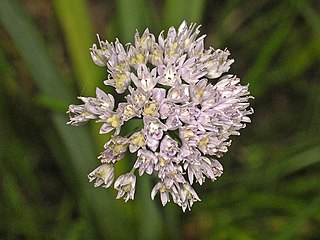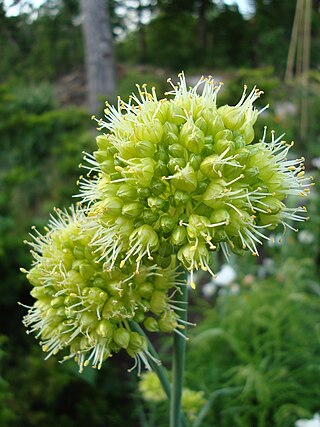
Lilium is a genus of herbaceous flowering plants growing from bulbs, all with large prominent flowers. They are the true lilies. Lilies are a group of flowering plants which are important in culture and literature in much of the world. Most species are native to the northern hemisphere and their range is temperate climates and extends into the subtropics. Many other plants have "lily" in their common names, but do not belong to the same genus and are therefore not true lilies.

Lilium martagon, the martagon lily or Turk's cap lily, is a Eurasian species of lily. It has a widespread native region extending from Portugal east through Europe and Asia as far east as Mongolia.

Lilium concolor is a species of flowering plant in the lily family which occurs naturally in China, Japan, Korea and Russia. Its relationship with other species is not clear, although it has some similarities to Lilium pumilum.

Allium strictum is a Eurasian species of wild onion. Its native range extends from France to Yakutia.
Allium amphibolum is a species of onion native to Altai, Tuva, Kazakhstan, Mongolia, and the Province of Xinjiang in western China.
Allium clathratum is a species of onions native to temperate Asia. It grows on dry slopes and cliff faces at elevations of 400–2000 m.
Allium eduardii is a plant species native to Russia, Mongolia, and northern China.
Allium leucocephalum is an Asian species native to Buryatiya, Zabaykalsky Krai, Mongolia, Inner Mongolia, Gansu, and Heilongjiang.

Allium lineare is a Eurasian species of wild onions with a wide range extending from France to Mongolia.

Allium mongolicum is an Asian species of wild onion native to Mongolia, Inner Mongolia, Tuva, Kazakhstan, and parts of China.

Allium maximowiczii, English common name oriental chive, is an Asian plant species native to Siberia, the Russian Far East, Mongolia, Japan, Korea and northeastern China.

Allium obliquum, common name lop-sided onion or twisted-leaf onion, is a Eurasian species of wild onion with a range extending from Romania to Mongolia. It is also widely cultivated elsewhere as an ornamental.
Allium polyrhizum is a species of wild onion widespread across Zabaykalsky Krai, Kazakhstan, Mongolia, and China at elevations 1000–3700 m.

Allium ramosum, called Fragrant-flowered Garlic or Chinese chives is a northern Asian species of wild onion native to Kazakhstan, Mongolia, Siberia, the Russian Far East, and northern China. The species is also naturalized in a few places in eastern Europe. In its native range, it grows at elevations of 500–2100 m.
Gagea altaica is an Asian species of plants in the lily family, native to Kazakhstan, Siberia, and Xinjiang Province of western China.
Gagea fedtschenkoana is an Asian species of plants in the lily family, native to Russia, China (Xinjiang), Kazakhstan, and Mongolia.
Gagea filiformis is an Asian species of plants in the lily family, native to Russia, China (Xinjiang), Kazakhstan, Kyrgyzstan, Tajikistan, Uzbekistan, Afghanistan, Pakistan, and Mongolia.
Gagea granulosa is a Eurasian species of plants in the lily family. It is native to Russia, Kazakhstan, China (Xinjiang), and Mongolia.

Gagea pauciflora is an Asian species of plants in the lily family. It is native to Mongolia, Russia, and China.

Gagea hiensis is a species of flowering plant in the lily family. It is native to Korea, Mongolia, China, and Far Eastern Russia.











